
Gaillardia pulchella is a North American species of short-lived perennial or annual flowering plants in the sunflower family.

Phacelia crenulata is a species of flowering plant in the borage family, Boraginaceae. Its common names include notch-leaf scorpion-weed, notch-leaved phacelia, cleftleaf wildheliotrope, and heliotrope phacelia. Phacelia crenulata has an antitropical distribution, a type of disjunct distribution where a species exists at comparable latitudes on opposite sides of the equator, but not at the tropics. In North America, it is native to the southwestern United States as far east as Colorado and New Mexico, and Baja California and Sonora in Mexico. In South America, it is native to southern Peru, western Bolivia, and northern Chile.

Talinum paniculatum is a succulent subshrub in the family Talinaceae that is native to much of North and South America, and the Caribbean countries. It is commonly known as fameflower, Jewels-of-Opar, or pink baby's-breath.

Glandularia, common name mock vervain or mock verbena, is a genus of annual and perennial herbaceous flowering plants in the family Verbenaceae. They are native to the Americas.

Lupinus succulentus is a species of lupine known by the common names hollowleaf annual lupine, arroyo lupine, and succulent lupine.

Downingia pulchella is a species of flowering plant in the bellflower family known by the common names flatface calicoflower and valley calicoflower. This showy, annual wildflower is endemic to California, where it is a resident of vernal pools and other wet places in the central part of the state from the Tehachapi Mountains to the San Francisco Bay Area.

Najas marina is a species of aquatic plant known by the common names spiny water nymph, spiny naiad and holly-leaved naiad. It is an extremely widespread species, reported across Europe, Asia, Africa, Australia, the Americas and many oceanic islands. It can be found in many types of freshwater and brackish aquatic habitat, including bodies of alkaline water.
Nemophila pulchella, known by the common name Eastwood's baby blue-eyes, is a species of flowering plant in the borage family. It is endemic to California, where it is found from the San Francisco Bay Area to the southern Sierra Nevada to the Transverse Ranges. It grows in many types of mountain, foothill, and valley habitats.

Glandularia gooddingii is a species of flowering plant in the verbena family known by the common name southwestern mock vervain. It is native to the southwestern United States and northern Mexico, where it occurs in sandy and rocky desert habitat. It is a perennial herb producing several hairy, decumbent to erect stems up to 45 centimeters long. The hairy leaves are generally divided at the base into a few lobes, which are edged with large teeth or small lobes. The plant blooms in large, dense, head-like spikes of many flowers. Each flower has a calyx of hairy sepals and a pale purple-blue corolla up to 1.4 centimeters long.
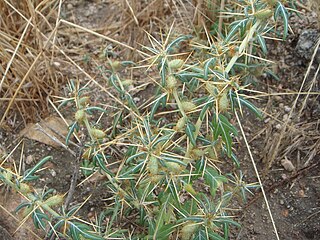
Xanthium spinosum is a species of flowering plant in the aster family known by many common names, including spiny cocklebur, prickly burweed and Bathurst burr. This species is part of the genus Xanthium that encompasses 25 different species of flowering plants of the daisy family, Asteraceae, and sunflower tribe.
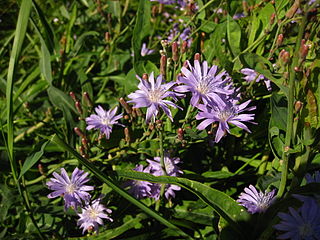
Lactuca tatarica, known as blue lettuce, is a Eurasian flowering plant in the tribe Cichorieae within the family Asteraceae. It is widespread across much of Europe and Asia.
Castilleja kerryana is a species of flowering plant in the family Orobanchaceae. It is commonly known as Kerry's Indian paintbrush or Kerry’spaintbrush. It was formally described in 2013 and so far it is known only from a small population in the state of Montana, in the Northwestern United States.
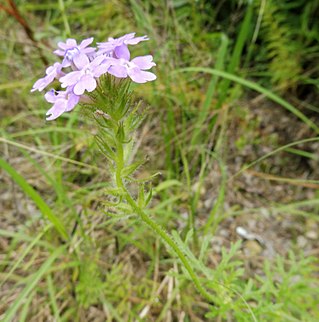
Glandularia bipinnatifida, commonly called Dakota mock vervain, prairie verbena, and Moradilla, among others, is a species of flowering plant in the verbena family (Verbenaceae).
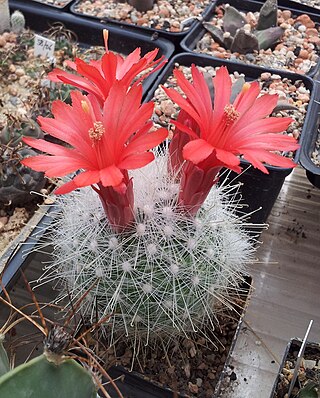
Mammillaria senilis is a species of cacti in the tribe Cacteae. It is native to Mexico, where it is found in the states of Chihuahua, Durango, Jalisco, Nayarit, Sinaloa and in south Zacatecas.
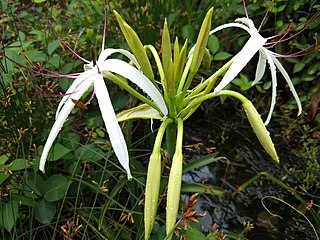
Crinum viviparum is a Monocot plant species in the family Amaryllidaceae distributed across Asia. No subspecies are listed in the Catalogue of Life.
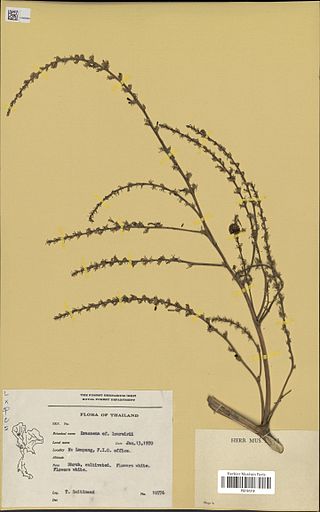
Dracaena cochinchinensis is a species of Asian tropical forest under-storey plants in the family Asparagaceae; no subspecies are listed in the Catalogue of Life.
Dracaena elliptica is a species of Asian tropical forest under-storey plants in the family Asparagaceae; no subspecies are listed in the Catalogue of Life.

Dracaena angustifolia is a species of Asian tropical forest under-storey plants in the family Asparagaceae; no subspecies are listed in the Catalogue of Life.
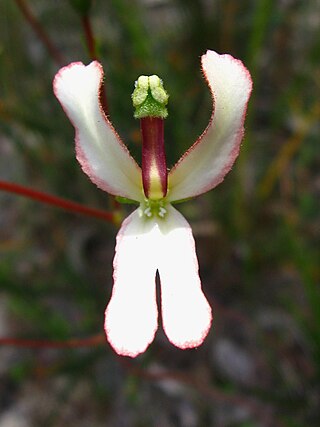
Stylidium schoenoides is a species of dicotyledon plant of the Stylidium genus, from Stylidiaceae family, Asterales order, first described by Augustin Pyramus de Candolle in 1839. The plant is endemic to Western Australia.

Echinocereus enneacanthus is a species of flowering plant first described by George Engelmann.

















